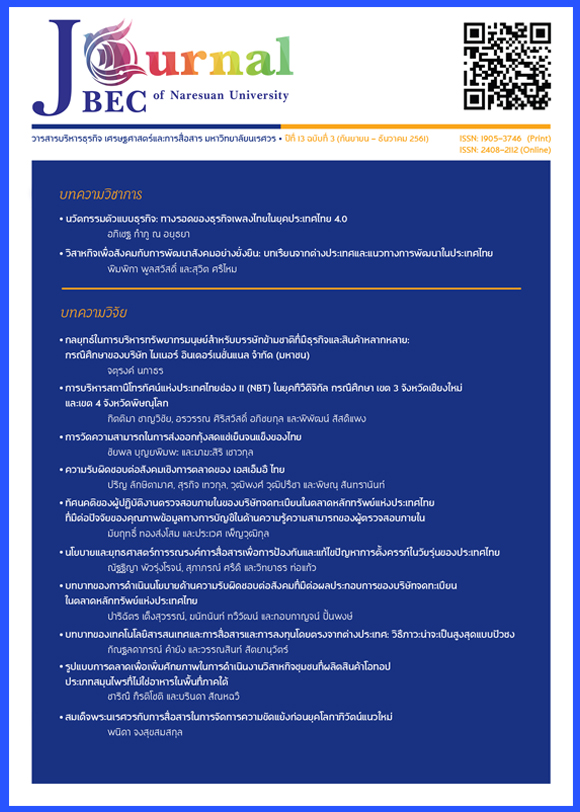สมเด็จพระนเรศวรกับการสื่อสารในการจัดการความขัดแย้งก่อนยุคโลกาภิวัตน์แนวใหม่
Main Article Content
บทคัดย่อ
บทความนี้เป็นการวิเคราะห์และศึกษาด้านการบริหารจัดการความขัดแย้งและการสื่อสารระหว่างประเทศในสมเด็จพระนเรศวร ด้วยวิธีการศึกษาเอกสารจากหลักฐานชั้นรองและหลักฐานที่เกี่ยวข้องกับความสัมพันธ์ระหว่างประเทศทั้งที่เป็นภาษาไทยและภาษาอังกฤษ และจากหลักฐานซึ่งเคยวิเคราะห์แล้ว หลักฐานชั้นตติยภูมิมาประกอบการวิจัย ผลการวิจัย พบว่า ความเป็นนานาชาติมีการเลื่อนไหลมาตั้งแต่ก่อนและในระหว่างช่วงเวลาที่สมเด็จพระนเรศวรทรงมีพระชนม์ชีพ พระองค์ทรงมีบทบาททั้งภายในราชสำนักและภายนอกราชสำนักโดยเฉพาะกับชาวต่างชาติ จนมีการกล่าวถึงในเอกสารหลักฐานต่าง ๆ ด้านบุคลิกภาพที่น่าเกรงขามเพราะพระปรีชาสามารถด้านการรบ การปกครองประเทศเพื่อสร้างความสัมพันธ์มี 2 ด้าน คือ 1) ด้านลบ กับอาณาจักรที่มีภูมิประเทศติดต่อกัน คือ สงคราม 2) ด้านบวก กับประเทศที่ไม่มีดินแดนติดต่อกัน อาทิ การค้า การทูต ชาวตะวันตกที่เข้ามามีสัมพันธไมตรีกับสยามจะเป็นราชทูต บาทหลวง พ่อค้า และเข้ามาในลักษณะทหารรับจ้าง พระราชพิธีทางการทูตคือการสื่อสารเชิงสัญลักษณ์ อันเป็นการกำหนดระยะห่างของพระองค์กับราชทูต
Article Details
References
2. Brummelhuis, H. T. (1987). Merchant, courtier and diplomat: A history of the contacts between the Netherlands and Thailand. Lochem: Uitgeversmaatschappij De Tijidstroom.
3. Carr, E. H. (1961). What is history?. England: Palgrave Basingstoke.
4. Delisle, J. and Woodsworth, J. (2012). Interpreters and the making of history. In Translators through history: Revised version (pp. 247-284). Amsterdam, Netherlands: John Benjamins Publishing.
5. Edward, T. H. (1981). Beyond culture. UK: Anchor books.
6. Gelfand, M. J. and Brett, J. M. (2007). The handbook of negotiation and culture. California: Stanford Business Books.
7. Gervaise, N. (1963). The natural and political history of the Kingdom of Siam. (S. T., Komolbutr, Trans.). Bangkok: Sripunya. (Original work published in France, 2018).
8. Hofstede, G. and Hofstede, G. J. (2005). Cultures and organizations: Software of the mind (2nd ed.). United States: McGraw-Hill.
9. Hofstede, G., Hofstede, G. J. and Minkov, M. (2010). Cultures and organizations: Software of the mind (3nd ed.). United States: McGraw-Hill.
10. Jacques de Coutre. (1665). The memoirs and memorials of Jacques de Coutre: Security, trade and society in 16th- and 17th-century Southeast Asia. (R., Roopanjali, Trans). Singapore: National University of Singapore Press. (Original work published in Portuguese, 2013).
11. Kasetsiri, C. and Sawasdsri, S. (2016). Knowledge in checking the annals of the Jubilee Chronicles. Retrieved October 20, 2017, from www.gis.finearts.go.th/
12. Nana, K. (2010). 500th anniversary years of relationship Thai – Portuguese. Bangkok: Matichon.
13. Prince Tisavarakumarn, the Prince Damrong Rajanubhab. (1933). Chronical of Siam and China diplomacy relationship. Bangkok: Sophonphipattanakorn Publishing.
14. Sakulratnamethi, P. and Pongsripien, V. (1997). Ming Sue Lue Record of Ayudhaya. In Srichamaiyajarn. Bangkok: The Thai History Development Council.
15. Suwanprathet, O. (2009). The Great King Naresuan, his powerful of defensive nation. Doctor of Philosophy thesis, Ph.D., Naresuan University, Phitsanulok.
16. Thomas, K. W. (2002). Introduction to conflict management: Improving performance using the TKI. CA: CPP.
17. Wade, G. (2003). The Ming shi-lu as a Source for Thai History-Fourteenth to Seventeenth Centuries. Journal of Southeast Asian Studies, 31(2), 249-294.

